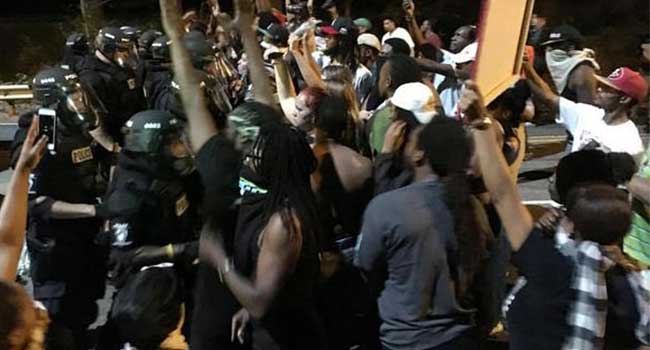
North Carolina Declares State of Emergency Following Second Night of Charlotte Protests
[UPDATE: September 23, 2016 12:30 p.m. CT]
The New York Times has released footage of the events leading up to the officer-related shooting of Keith Scott.
In the video, shot by Keith's wife, Rakeyia, you can hear police shouting out commands for Scott to, "Drop the gun!"
Rakeyia tries to tell police officers that Scott doesn't have a gun, that he has a TBI, or traumatic brain injury.
Shortly after, officers plead with Scott again to drop the gun, to which Rakeyia responds with, "Don't you do it!"
See the video below.
[UPDATE: September 22, 2016 10:00 a.m. CT]
At a press conference Thursday morning, Charlotte-Mechlenburg Police Chief Kerr Putney said nine victims were injured in the protests last night. The two of the four officers injured were taken to the hospital with eye injuries and the other two had heat-related injuries.
A total of 44 protesters were arrested during the unrest.
Answering questions about the officer-involved shooting of Keith Scoot, Chief Putney said the family of Scott has asked to see the footage of the shooting and they will honor that request. The video will not be publicly released as Putney believes it would add to the unrest Charlotte is seeing presently.
"The video does not give me absolute definity, visual evidence that would confirm that a person is pointing a gun," Chief Putney said. "I did not see that in the videos that I reviewed. What I can tell you, is that it does add to the evidence of the accounts that I have heard that led to the death of Mr. Scott."
Chief Putney also said there are conversations for an outside investigation of the incident on-going.
Original story below.
For a second night in a row, violent protests plagued Charlotte following the officer-involved shooting of an African-American man on Sept. 21, prompting North Carolina’s governor to declare a state of emergency.
At least four police officers suffered non-life threatening injuries in the protests and a civilian is on life-support after being shot by another civilian protester during the unrest.
While the protests began peaceful on Wednesday afternoon, they soon turned violent as night fell. The unrest began when some protesters flipped over trash cans and set the contents on fire. Onlookers cheered and other shattered windows of the buildings and cars around. “Black Lives Matter” was spray-painted in black on business windows.
Stores in Charlotte were looted, and a CNN freelance photographer described a scene where protesters knocked over an ATM and took the money from it. The Hyatt House Hotel in downtown went into lockdown as rocks were flown through windows, and a valet and desk attendant were punched in the face.
Police attempted to disperse crowds with tear gas and formed blockades with their bodies, that were outfitted in riot gear.
Gov. Pat McCrory declared a state of emergency during the unrest, stating that he would deploy the National Guard and Highway Patrol to North Carolina’s largest city.
“We cannot tolerate violence. We cannot tolerate the destruction of property and will not tolerate the attacks against our police officers that is occurring right now,” McCrory said.
Charlotte Mayor Jennifer Roberts has said she would consider a curfew if the protests continue.